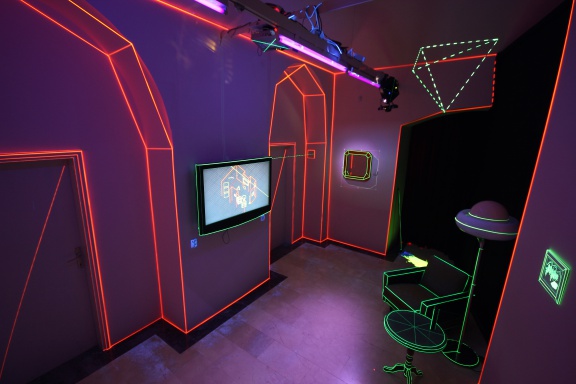Introduction to New Media Art in Slovenia
Terminology
If arts are supposed to be a place where understanding, integration and preparation of future developments take place, then new media art is already part of that future. As a response to the artistic use of technologies invented and/or made widely available since the mid 20th century, a new generic term new media art or media art (Medienkunst in German) was coined, replacing the former multimedia or mixed media.
In Slovenia the new media arts are referred to as intermedia arts, reflecting their often ineffable and inter-disciplinary activities that cross and fuse boundaries of traditional media or genres. In general all artistic practices that use unstable, variable and dynamic media (or technologies) to express themselves in interdisciplinary ways can be acknowledged as Intermedia. The Section for Intermedia Arts, Ministry of Culture defines Intermedia arts as ‘artistic practices that in an act of creation use information technology, robotics, electronic networks, cybernetics, telepresence, virtual reality, multimedia and "extended body", including also interactive performance, installations, net art and urban public intervention.’
On the Culture.si portal, however, we have been using new media art as terminus technicus.
Background
Intermedia is a vital and diverse artistic sector in Slovenia that has seen intensive development during the last decade. It was foreshadowed in the 1980s by alternative art forms staged at venues such as Škuc Gallery. The most prolific artists experimenting in video during that period included the duos Srečo Dragan & Nuša Dragan, Zemira Alajbegović & Neven Korda and Marina Gržinić & Aina Šmid, new technology being also an integral part of performances by Ema Kugler, Marko Kovačič and Marko Košnik, and of work by the Neue Slowenische Kunst groups (including music by Laibach, visual art by Irwin and Sestre Scipion Nasice theatre directed by Dragan Živadinov, who later developed Noordung Cosmokinetic Cabinet). See also the Visual arts, Performing arts and Film chapters for art, theatre and video practices related to Intermedia arts.
Development and production modes
Intermedia art has changed the landscape of creation as well as that of cultural management and production. Several intermedia projects and their exponents – the HEXPO festival of self-organised cultural forms – reiterated the significance of the liberating use of technology – new media that promote creation and imagination, participation and choice over representation, spectatorship and consumption.
It was characteristic of new media artists that they had to develop their own technological means of expression, and because of this working process they started to build their own new systems of production and communication. The main protagonists of today’s Slovene new media arts are internationally-acclaimed artists (and theorists) who attained impressive and pioneering achievements during the 1990s, when they also managed to establish their own creative artistic platforms: Marko Košnik (Egon March Institute), Marko Peljhan (Projekt Atol Institute), Igor Štromajer (Intima Virtual Base), and Davide Grassi (Aksioma Institute). Other individual authors who broke ground at this time included Vuk Ćosić, Darij Kreuh, Damijan Kracina, Vadim Fiškin, Borut Savski, Luka Frelih and Jaka Železnikar.
Artists
The first generation’s artistic point of departure was performing arts (theatre in case of Peljhan and Štromajer, and music/sound in case of Košnik or Savski); some individuals also started to emerge from Academy of Fine Arts and Design (Kreuh, Kracina, and later Sašo Sedlaček, Polona Tratnik, etc.) and to collaborate with graduates of the Faculties of Computer Engineering in Ljubljana and Maribor (ArtNetLab). Of all the artistic disciplines, intermedia artists are the most internationally involved as far as project co-production (artistic collaboration as well as funding) and education is involved: while the older generation lectures in Europe, America and Asia, the young generation has taken interdisciplinary studies (sound, visual arts and media arts) in such places as London, Graz, Vienna and Venice.
Institutions and venues
During the 1990s creative diversity in the field of Intermedia arts was backed up by the emergence of a handful of organisations and producers, including Ljudmila - Ljubljana Digital Media Lab, Kapelica Gallery and KIBLA Multimedia Centre. Today all of them are renowned in international new media circles for their participation in intermedia festivals, conferences and networks (e.g. ISEA, Ars Electronica festival, Transmediale Berlin, Dutch Electronic Arts Festival (DEAF), SEAFair in Skopje, European Cultural Backbone (ECB), European Multimedia Forum, Webby Awards), where they have promoted and sought new models of co-production as well as new funding sources, both locally and internationally.
Other important venues for intermedia arts presentation during the past 15 years included P74 Centre and Gallery (which promoted emerging artists) and occasionally Škuc Gallery and the Mala Gallery, Museum of Modern Art, while bigger overview exhibitions were shown at Museum of Modern Art Ljubljana. In Maribor, KiBela Art Space at KIBLA Multimedia Centre also presented several intermedia arts projects. The Slovenian Cinematheque was an important venue for audio-visual projects. At the same time Slovenia acquired two festivals dedicated to intermedia arts, and a several others that included intermedia projects. Established in 2001, Cyberpipe in Ljubljana is another vibrant intermedia arts catalyst. Today the M3c Multimedia Centres Network of Slovenia, set up recently with state and European support, has a growing membership of 15 intermedia arts organisations.



